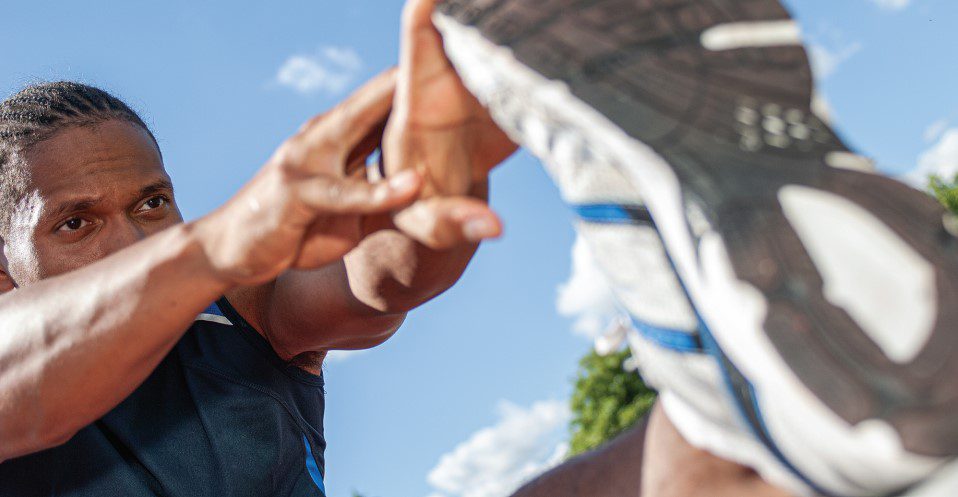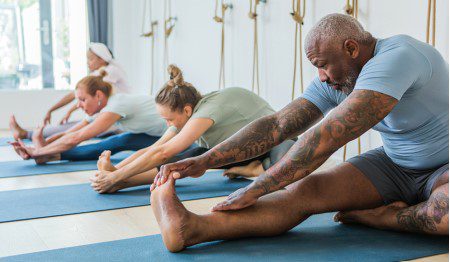
[By Niveen Girgis, PT, DPT, FMS, CKTP, Physical Therapist with St. Peter’s Health Partners Patient Therapies.]
For your brain and body, stretching is a simple yet effective exercise with more benefits than you can imagine! Stretching increases blood flow to muscles and organs, which allows for improved delivery of oxygen and other nutrients essential for better mental health and physical function.
It is important to include stretching in your daily exercise plan for several reasons. Daily stretching can:
- Increase your flexibility and range of motion, which can help you move better throughout the day.
- Help reduce your risk of injury.
- Improve your posture by relieving aches and pains in your lower back, chest, and shoulders.
- Help you feel calmer and more at ease by reducing muscle tension.
- Prepare your body for the stress of exercising.
- Improve your mood and focus, as well as relieve tension headaches.
If stretching has all these great benefits, why do so many people avoid it? Is it lack of knowledge of how to stretch? Or a misconception it is too time consuming? Even 5-10 minutes of stretching can be beneficial, if done consistently, and the benefits are enormous!
There are several types of stretching, but let’s focus on two important ones: Dynamic and Static.
 Dynamic stretching consists of controlled leg and arm movements that take you to the limits of your range of motion. Dynamic stretching is often used before exercise as a warmup to help prepare your muscles for the activity or sports you’re about to do. It’s also great to do in the morning after waking up, as it’s often gentler on your muscles than static stretching, and it can help wake you up and get you started for your day.
Dynamic stretching consists of controlled leg and arm movements that take you to the limits of your range of motion. Dynamic stretching is often used before exercise as a warmup to help prepare your muscles for the activity or sports you’re about to do. It’s also great to do in the morning after waking up, as it’s often gentler on your muscles than static stretching, and it can help wake you up and get you started for your day.
Static stretching involves taking a muscle to its farthest point and holding that position for at least 30 seconds. Static stretches are often used at the end of a workout as part of a cool-down routine to prevent injury.
Here are some tips for static stretching safely and effectively after a workout:
- Go slowly: Keep stretches gentle and slow, and don’t bounce.
- Breathe: Breathe through your stretches. Make sure you are relaxed!
- Hold: Hold the stretch for at least 30 seconds, or until you feel a slight pull that is comfortable and not painful.
- Repeat: Repeat the stretch on both sides 2–4 times.
- Stretch regularly: Aim to stretch major muscle groups at least 2–3 days a week.
- Consider your health: If you have health conditions or injuries, please consult a healthcare professional or physical therapist about which stretches are right for you.
The Rehabilitation Services program, located at Samaritan Hospital – Albany Memorial Campus (600 Northern Blvd. in Albany), is a part of St. Peter’s Health Partners Patient Therapies. It is a unique outpatient program dedicated to providing individualized comprehensive care for patients recovering from surgery, injury and medical illness.
In addition to traditional physical therapy, the Albany Memorial Campus location provides special services including rehabilitation of hand and arm disorders, treatment of urinary incontinence/pelvic pain disorders, lymphedema, concussion, and scoliosis, as well as neurological conditions like multiple sclerosis, stroke, and Parkinson’s.
Our specialized staff of occupational, speech, physical and certified hand therapists are dedicated in helping you achieve your goals for recovery. For more information, call 518-471-3195 or visit https://www.sphp.com/location/rehabilitation-services-albany-memorial-campus.





